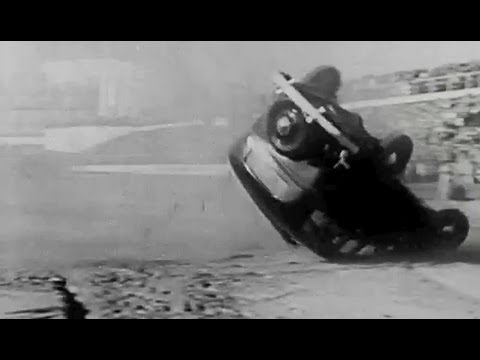more at
Toughness of the 1936 Plymouth is demonstrated by showing how components, structures, and the entire vehicle are “torture tested.” Includes several good shots of deliberately rolling cars, and daredevil driving by “Hell Drivers’ such as Lucky Teter and Jimmy Lynch.
NEW VERSION with improved video & sound:
Public domain film from the Prelinger Archive, slightly cropped to remove uneven edges, with the aspect ratio corrected, and mild video noise reduction applied.
The soundtrack was also processed with volume normalization, noise reduction, clipping reduction, and/or equalization (the resulting sound, though not perfect, is far less noisy than the original).
Plymouth was a marque of automobiles based in the United States, produced by the Chrysler Corporation and its successor DaimlerChrysler. Production was discontinued on June 29, 2001 in the United States.
The Plymouth automobile was introduced on July 7, 1928. It was Chrysler Corporation’s first entry in the low-priced field, which at the time was already dominated by Chevrolet and Ford. Plymouths were actually priced slightly higher than their competition, but offered all standard features such as internal expanding hydraulic brakes that the competition did not provide. Plymouths were originally sold exclusively through Chrysler dealerships. The logo featured a rear view of the ship Mayflower which landed at Plymouth Rock. However, the Plymouth brand name came from Plymouth Binder Twine, chosen by Joe Frazer for its popularity among farmers…
The origins of Plymouth can be traced back to the Maxwell automobile. When Walter P. Chrysler took over control of the troubled Maxwell-Chalmers car company in the early 1920s, he inherited the Maxwell as part of the package. After he used the company’s facilities to help create and launch the Chrysler car in 1924, he decided to create a lower-priced companion car. So for 1926 the Maxwell was reworked and re-badged as the low-end Chrysler “52” model. In 1928, the “52” was once again redesigned to create the Chrysler-Plymouth Model Q. The “Chrysler” portion of the nameplate was dropped with the introduction of the Plymouth Model U in 1929.
Great Depression, 1940s and 1950s
While the original purpose of the Plymouth was to serve a lower-end marketing niche, during the Great Depression of the 1930s, the marque helped significantly in ensuring the survival of the Chrysler Corporation in a decade when many other car companies failed. Beginning in 1930, Plymouths were sold by all three Chrysler divisions (Chrysler, DeSoto, and Dodge). Plymouth sales were a bright spot during this dismal automotive period, and by 1931 Plymouth rose to the number three spot among all cars. In 1931 with the Model PA, the company introduced floating power and boasted, “The economy of a four; the smoothness of a six.” In 1933 Chrysler decided to catch up with Ford and Chevrolet with respect to engine cylinder count. The 190 cu in version of Chrysler’s flathead-6 engine was equipped with a downdraft carburetor and installed in the new 1933 Plymouth PC, introduced on 17 November 1932. However, Chrysler had reduced the PC’s wheelbase from 112 in (284.5 cm) to 107 in (271.8 cm), and the car sold poorly. By April 1933, the Dodge division’s Model DP chassis, with a 112 in (284.5 cm) wheelbase, was put under the PC body with DP front fenders, hood, and radiator shell. The model designation was advanced to PD and the car was marketed as the “DeLuxe” 1933 Plymouth. This car sold very well and is the 1933 model most commonly found in collections. The PC became the ‘Standard Six’. It had been the ‘Plymouth Six’ at introduction, and was sold through to the end of 1933, but in much lower numbers. It is consequently in the minority in collectors’ hands today. In 1937, Plymouth (along with the other Chrysler makes) added safety features such as flat dash boards with recessed controls and the back of the front seat padded for the rear seat occupants. The PC was shipped overseas to Sweden, Denmark, and the UK, as well as Australia. In the UK it was sold as a ‘Chrysler Kew’… The flathead 6 which started with the 1933 Model PC stayed in the Plymouth until the 1959 models.
In 1939 Plymouth produced 417,528 vehicles, of which 5,967 were two-door convertible coupes with rumble seats. The 1939 convertible coupe was prominently featured at Chrysler’s exhibit at the 1939 New York World’s Fair, advertised as the first mass-production convertible with a power folding top. It featured a 201 cu in, 82 hp version of the flathead six engine.
For much of its life, Plymouth was one of the top-selling American automobile brands; it together with Chevrolet and Ford were commonly referred to as the “low-priced three” marques in the American market…

